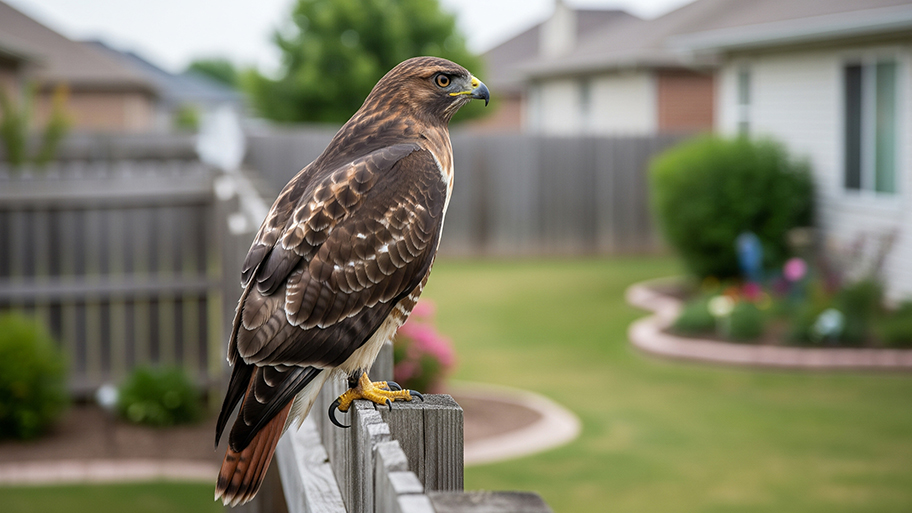
Raccoons on your property can cause a lot of damage to your home and yard. This guide breaks down raccoon removal costs so you can budget accordingly.
They don’t attack humans, but that doesn’t mean they’re welcome on your property


Bobcats are a type of big cat (also known as a red lynx) native to North America that can be found in nearly every state. Seeing, hearing, or finding evidence of a bobcat around your property is not unheard of. The good news is that once you learn how to keep bobcats away from your home, you can use the same methods to ward off other predatory creatures like wolves and coyotes.
Luckily, bobcats don’t attack humans and aren’t aggressive to people. But they prey on small animals like mice, chickens, and rabbits and could go after your pets or farm animals. So, to be on the safe side, let’s dig into some natural, proven methods for how to keep bobcats away.
Keeping a clean property is one of the most natural and simplest deterrents for bobcats and many other kinds of predators. It’s easier for a bobcat to make its way onto your property if they have lots of spots to hide, like dense forest, vegetation, or a large wood pile.
Trim your bushes and trees regularly to prevent overgrowth and keep visibility clear. If you’ve been working on any outdoor projects like building a deck, make sure there are no gaps in construction or pathways that would allow a bobcat or another predator to access your home. The harder it is for a bobcat to enter your property, the less likely it’ll stick around.

Bobcats are most active at night, especially in twilight and the wee hours before the sun begins to rise. To keep them from venturing onto your property, install motion-activated lighting that will snap them out of their shadowy comfort zone, or if the cost of motion-sensor lights is beyond your budget, try solar-powered lights that will charge up during the day and stay on through the night. This is also a common method for keeping other kinds of predators away, like coyotes, wolves, and foxes.

If you have a big or medium-sized dog, your furry friend could be your best weapon against the threat of bobcats on your property. Bobcats are naturally shy and won’t want to face off with a dog, so sending your pup out for a regular romp in the yard can sometimes be enough to deter one from coming by.
Remember, though, the average bobcat is 2 to 3 feet long and 15 to 40 pounds. Be sure Fido is larger than that before you send him off to defend the fort, and keep smaller dogs inside or on a leash.
Providing safe shelter for your barnyard animals or small pets is imperative in keeping bobcats away. Otherwise, they could be attracted to their scent and try to attack your animals as a food source. If your animals need to roam outdoors at night, make sure they’re bordered by a fence at least 6 feet high (the taller, the better) since bobcats are good jumpers and climbers. Bobcats are also likely to target smaller domesticated cats, so be sure to keep them indoors at night if you can.
Like most wild animals, bobcats are attracted to any place where there is food that they can scavenge or hunt. If you leave pet food outside, for example, a bobcat is more likely to visit your property. The same goes for things like fallen fruit from trees, bird seed, or smaller free-roaming animals, like chickens or ducks. It’s important not to let your pets roam the outdoors unattended at night when bobcats are likely to be active and hunting.
Your trash may not be as secure as you think it is. Invest in a lockable garbage bin for your food waste to keep animals out of your yard.
Even if you know how to keep bobcats away, you could run into one in the wild or on your property. Scare it off by shouting loudly and waving your arms. Most bobcats will run away once they realize you’re a human being, but some may not due to being ill or rabid. If that’s the case, call your local wildlife control pros to report the bobcat and have it removed.
There is never a scenario in which any average person should try handling a bobcat or its kittens on their own because it’s very dangerous. Plus, it’s worth the cost of wildlife removal to save a pet or barn animal’s life in the future.
Bobcats are a protected species, so you’ll need to contact a professional to remove and relocate them. The cost of removing a bobcat varies by location, but in general, wildlife removal costs range between $200 and $600.
I contacted the chimney guys last week for an inspection and cleaning service, everything is done and thank goodness they came because they removed a lot of dirt and they told me that the person who came for maintenance last year had done nothing! So now you have my trust.
They worked with us so that we were able to remove our loan contigency in less than 21 days!
We've used Gerald twice to inspect homes we were trying to purchase. The second home was a multiple-bid situation with a short contingency removal period. Gerald was very accommodating and told us to go ahead and book an inspection appointment (prior to us knowing if we won the house) and to...
He came and found a leak under the house not an animal.
I received several bids to remove one very large tree, several smaller trees and some hillside clearance. David was the rep who came out to bid the job. His knowledge was impressive and the bid was so much less expensive than 3 other bids that I was a bit skeptical, It seemed too good to be...
I was not very happy with that man. I called him because I wanted him to come out and look at my dead tree that needs to be removed. He asked me to take pictures of the tree. With a cell phone camera you can’t get a good picture of a tree that is 25-30 feet high. I emailed him the...
I originally found Santa Monica Plumbing with the BBB where they has a AAA rating. It was borne out by the service they provided. I have used them three times. First, I had a leaky faucet in the bathroom and needed my washer drain snaked out. The washer drain was particularly challenging...
From average costs to expert advice, get all the answers you need to get your job done.

Raccoons on your property can cause a lot of damage to your home and yard. This guide breaks down raccoon removal costs so you can budget accordingly.

When budgeting for possum removal costs, consider number of animals, location, method of removal, and whether you do it yourself or hire a professional.

While moles eat termites, ants, and more, they can still be a nuisance. Learn yard mole removal costs, including humane options to decide what’s right for you.

Hawks are expert overhead hunters. To protect your pets and the little birds visiting your backyard, learn how to keep hawks away with these humane strategies.

If you are wondering who to call for raccoon removal, these pros will handle your situation humanely and according to local guidelines.

When chipmunks start swinging from the bird feeder, it's time to take action. Here’s how to get rid of chipmunks, from natural repellent to barriers.